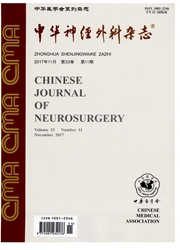

 中文摘要:
中文摘要:
目的研究亚低温治疗状态下重型颅脑创伤(sTBI)患者伤后早期脑组织氧分压(PbtO2)的动态变化及临床意义。方法38例sTBI患者进行亚低温治疗,连续监测PbtO2、颈静脉血氧饱和度(SjvO2)、颅内压(ICP)、和脑灌注压(CPP)等指标,对监测结果以及PbtO2和其他指标相关性进行分析,并记录患者伤后3个月的格拉斯哥预后评分。结果在亚低温治疗初期,患者PbtO2、SjvO2和CPP明显上升,ICP明显下降,而治疗36h和48h后PbtO2及SjvO2无明显变化。亚低温治疗后ICP较治疗前明显下降,低PbtO2隋况明显改善,ICP和PbtO2之间呈负相关;PbtO2及SjvO2水平明显上升,PbtO2与SjvO2呈直线正相关;PbtO2与CPP呈直线正相关。监测过程中,在SjvO2和CPP水平正常的情况下,仍有较大比例的患者出现低PbtO2隋况。治疗过程中没有出现过低PbtO2水平的患者预后良好。结论PbtO2是监测sTBI患者局部脑组织氧合的一项重要指标,具有很高敏感性,对于指导治疗和判断预后具有重要意义,而亚低温能够明显改善PbtO2降低的情况。
 英文摘要:
英文摘要:
Objective To investigate clinical significant and changes of brain tissue partial pressure of oxygen (PbtO2 ) in the course of mild hypothermia treatment (MHT) of severe traumatic brain injury (sTBI). Methods There were 38 sTBI cases with mild hypothermia treatment in the course. PbtO2, intracranial pressure (ICP), jugularn venous oxygen saturation ( SjvO2 ), and cerebral perfusion pressure (CPP) were continuously monitored for analyzing the correlations insides, and clinical outcomes were valued using the Glasgow Outcome Scale score (GOSs). Results Of 38 patients with sTBI, increasing PbtO2, SjvO2, CPP and decreasing ICP were found obviously from the begin of MHT. There was negative linear correlation between PbtO2 and ICP. Otherwise, there was positive linear correlation between PbtO2 and SjvO2. Monitoring process which CPP and SjvO2 levels were under normal circumstances, there were still a large proportion of patients with low PbtO2 situation after MHT. Conclusions Continuous monitoring of PbtO2 can reflect the condition of regional cerebral oxygen metabolism and guide treatment and predicting outcome.
 同期刊论文项目
同期刊论文项目
 同项目期刊论文
同项目期刊论文
 期刊信息
期刊信息
